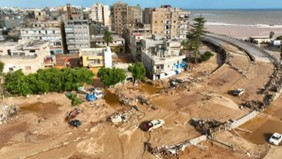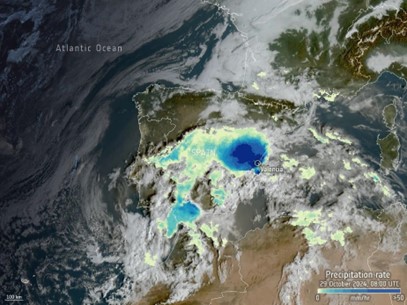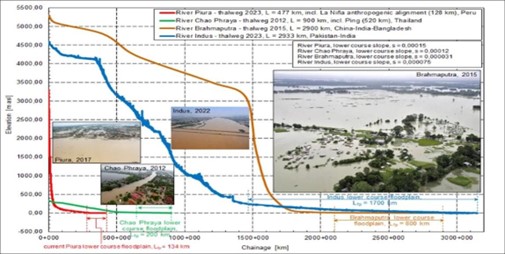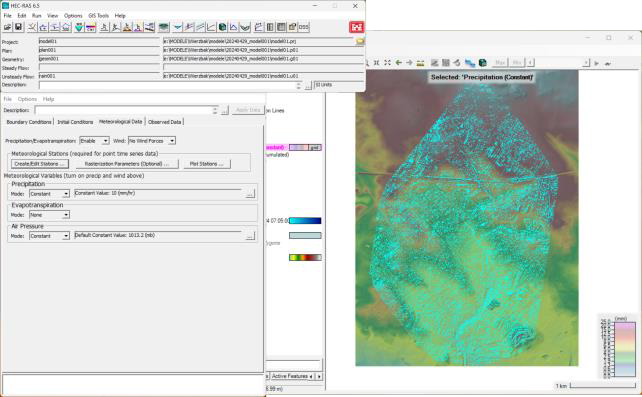Advances in Flood Risk Management 2024
Newsletter 1, 2024 from the IAHR Technical Committee on Flood Risk Management
Recent flood events around the world
In the recent months, we have seen disastrous flooding events around the World. The storm Daniel, which moved across the Mediterranean Sea, hit the coast of Libya in September 2023. It happened shortly after the 40th IAHR World Congress in Vienna. The storm caused the collapse of two dams and a humanitarian disaster in the city of Derna (Fig. 1a). According to BBC (10th October 2023), the number of people who died was at least 4,000, and about 10,000 were reported missing. However, different sources provide other data, e.g. the city mayor quoted by SkyNews (14th September 2023) estimates that the number of deaths reaches 20,000. Pictures of destruction in Derna along the river of Wadi Darnah show the devastation that can result from a dam collapse. Also in September 2023, two typhoons, Soala and Haikui, hit Southeast Asia, mainly Hong Kong and Taiwan.
South America has been experiencing the effects of El Niño, the global phenomenon consisting of wind and sea surface temperatures in the tropical zones of the Pacific Ocean. Extreme rainfall has been recorded in Colombia, Argentina, Brazil, and other countries on the continent. The worst disaster to date has occurred in the Rio Grande do Sul (Brazil) in April 2024 (Fig. 1b). The number of people who died was close to 200 (UN, 7th July 2024). Property damage is estimated at around US$ 3.7 billion (O Globo, Brazil, 9th May 2024).


According to the report provided by the EU’s Copernicus Climate Change Service, about 30% of European rivers exceeded flood thresholds in 2023. This year, parts of Belgium, the Netherlands, France, and Germany were declared to be in the state of emergency in May. The Central Asian countries of Pakistan and Afghanistan experienced severe floods between March and July 2024.
According to the analyses presented by the European Commission in 2023, higher losses are expected in EU countries. Studies of changes in EAD (Expected Annual Damage) associated with future climate scenarios RCP4.5 and RCP8.5 indicate the future increases in flood losses first in Germany, France, and Italy, and then in other countries. The Global Flood Database also publishes projections of increases in the exposure to flood losses around the world.
In September 2024, as this newsletter was being prepared, Austria experienced devastating flo oding caused by Storm Boris and record rainfall. Records show that the city of Vienna received five times more rainfall than is typical for September, causing widespread flooding and disruption to critical infrastructure. As a result of the flood protection measures implemented, particularly after the 2002 and 2013 floods, major damage was prevented. However, it is also important to mention the preparedness resulting from accurate forecasting. The same storm caused widespread flooding across several areas in Italy, including the Emilia-Romagna region, which was already heavily impacted in 2023. The recent floods resulted in extensive damage and led to the evacuation of approximately 2,000 people.
Recently, flash floods occurred in southern and eastern Spain as a result of torrential rainfall. Precipitation rates in the area of Valencia are shown in Figure 2, which shows that this area received a year's worth of rain in just eight hours. According to the European Space Agency (ESA), which assessed the damage to the affected areas using satellite imagery, more than 4,100 hectares and 3,906 buildings were affected, while more than 60,000 people, about 15 km of railways and 531 km of roads were potentially affected; more than 200 people lost their lives and thousands were displaced.
Both events underscore the increasing unpredictability and severity of weather patterns linked to climate change, and raise concerns about infrastructure resilience and emergency preparedness in flood-prone areas across Europe.

Recent conferences, events, and workshops
Interesting events related to flood management and flood science have taken place in the last few months. In June 2024, the 8th IAHR Europe Division Congress was held in Lisbon. Flood issues were presented and discussed in the Thematic Session E, “Climate Change and Risk Mitigation.” There were four sessions dedicated to floods, with a total of 27 presentations in total. The discussions focused on topics such as "Soft computing for modelling floods and droughts”, “Monitoring, responding, and recovering from floods and droughts”, “Understanding and assessing compound flood risk in the coastal zone”, and “Disaster risk management in European rivers and coastal areas.”
At the end of last year, an interesting event took place in France in November. The SimHydro 2023 conference focused on “New modeling paradigm for water issues?”. Prof. Benjamin Dewals, a member of the Flood Risk Management Technical Committee, was the keynote speaker. Prof. Dewals gave a presentation on catastrophic floods and their consequences in Belgium in 2021. The event also included two sessions dedicated to floods, “Floods & extreme events,” and one session presenting new techniques for flood assessment, namely “Development of flood models.”
Advanced flood modelling issues were also the focus of two other events this year. The first was organized by the University of Sheffield, UK, in February. This two-day conference, SEAMLESS- WAVE, focused on “Advances in flood modeling and forecasting.” The second took place in Beijing, China, and it was the 15th International Conference on Hydroinformatics. In China, there were four sessions focused on floods such as “Flash Flood Program: Advanced Hydroinformatic approaches for flash flood defence and prevention”, “Urban flooding and waterlogging”, “Modelling and machine learning for understanding flash floods and mitigating their impact on Society,” and “Climate Change Impacts on Urban Flooding: Challenges and Innovative Solutions.”
In June, just before the European Congress, the 16th International Conference on Urban Drainage was held in Delft, the Netherlands. Urban flooding was one of the main themes of the event.
This year, there will also be congresses of other local divisions. At the beginning of October, there will be the 31st Hydraulic Congress of Latin America (XXXI Congreso Latinoamericano de Hidrálica) will be held in Medellín, Colombia. In the same month, but a little later, the 24th IAHR Asia and Pacific Division Congress in Wuhan, China, will take place. At the end of the year, in December, the 6th IAHR Africa Congress will be held in Marrakech, Morocco. There will also be a River Flow conference be held. This time, it will take place in Liverpool, UK. It´s worth mentioning that this year, the 1st International Conference on Smart Informatics and Multi-hazard Reduction (SIMR 2024) will be organized. Flooding issues will be discussed at all these events mentioned. Also, the 5th edition of the IAHR Young Professionals Congress will consider Flood Risk Management as a theme and will enable networking between young professionals and experts in the field.
Recent activities of TC members
The new knowledge source, the monograph on Practical Flooding Risk Assessment for Development Projects, is available. The publication is a part of the IAHR Water Monographs Series. In this volume, the Committee member, Prof. Alastair Barnett, and his co-authors provide information on various aspects of flood modelling, mapping, and technical solutions. The monograph includes descriptions of real-life examples and analyses of lesser-known tsunami mitigation issues. The book can be an excellent resource for students and experienced professionals.
Committee experts participated in knowledge sharing activities. Dr. Tomasz Dysarz gave four courses for students and academic workers of the Petra Christian University in Indonesia from April to May 2024. This cooperation started after the 40th IAHR World Congress in Vienna, Austria. The courses focused on river flow simulation in HEC-RAS and the generation of flood hazard maps by using the QGIS package. The sessions were organized online and recorded. The recordings will be published as regular workshops on the IAHR FRM-TC webpage. The cooperation is developing, and new events of this kind are planned for the future.
Committee member Prof. Cesar Adolfo Alvarado Ancieta, has been involved in a project founded by Asian Development Bank (ADB). In the frame of the project the flood protection and urban drainage problems are analyzed in the several river basins around the World (Fig. 2). The project focuses on flood reduction vulnerability in five cities of Thailand. In addition, to the project Prof. Alvarado compares watersheds located in different countries including Peru, Thailand, Pakistan, India and Bangladesh. This will be increased with data analysis for other rivers in Europa, as the Rhine and Elbe, and the Ucayali and Amazonas in South America. The idea is to determine the vulnerability reduction requirements with respect to different climate conditions as well as differences in the density of population.

Technological change
We have been observing for months how new computational features are being incorporated into widely used hydrodynamic software, e.g., such as HEC-RAS (Fig. 3). The most important new procedures seem to be the application of precipitation and infiltration in the source terms of 2D models. These are generally implemented in combination with 1D models of closed conduits for rainwater collection.
The first two have so far been reserved for hydrological models, e.g., HEC-HMS, until now. Their application in 2D hydrodynamic models appears to be a technological change, allowing more accurate and more reasonable simulations of water circulation between the atmosphere, land surface, and soil. The implementation of these elements in1D models for networks of closed conduits is not accidental. They inevitably lead to simulations of urban flash floods in very complex configurations, including roads, pavements, and buildings, as well as hidden infrastructure such as canals or semi-natural urban areas such as parks.
Until now, the new features have been available in HEC-RAS. However, they are also available in Telemac-2D or in the lesser-known Iber (Flumen Institute, Barcelona, Spain). The first comparisons have even been published, for example in Frontiers in Water by a team from the Norwegian University of Science and Technology led by Nitesh Godara. Given the growing threat of urban flooding and the importance of related issues, we can expect future developments in this area.

Upcoming conferences, events, and workshops
5th IAHR Young Professionals Congress (online, November 2024) – “Flood Risk Management” session –
The Flood Risk Management sessionof the 5th IAHR Young Professionals Congress (online, 27-29 November 2024) will be chaired by FRM-TC members. The IAHR Young Professionals Congress is an online, free-of- charge Congress, a wonderful opportunity for early-career scientists from all over the world to present their work and get mentoring from leading experts. More information can be found here41st IAHR World Congress (Singapore, June 2025) – “Integrated Flood Risk Management: From Science to Practice” special session –
The special session on Integrated Flood Risk Management: From Science to Practice is organized by FRM- TC members. The session aims to bridge the connection between scientific researchers, practitionersand flood managers, which will result in a wide variety of presentations. We solicit papers on experiences in field deployment and application of flood risk management tools, discussion of barriers to technology adoption for flood defense and management, and multidisciplinary research and application of flood risk assessment and management.
New Co-Opted member
We welcome Prof. Reza Ahmadian, director of International at School of Engineering, Cardiff University, to our community. Thanks to his experience and expertise, he will effectively contribute to the initiatives and objectives of the FRM Technical Committee.
This newsletter is edited by Tomasz Dysarz, Ravindra Vitthal Kale, and Daniele P. Viero. If you are interested in presenting actual developments within our newsletter, please send your contributions to Dr. Tomasz Dysarz
Related